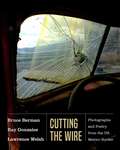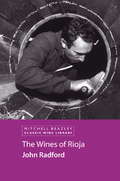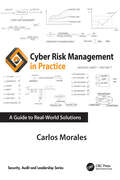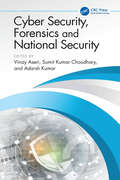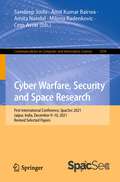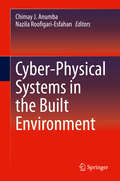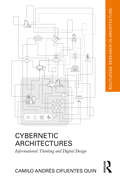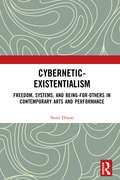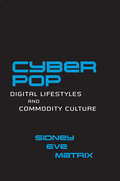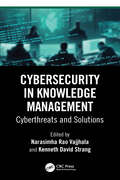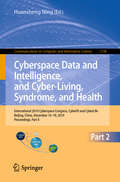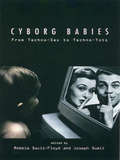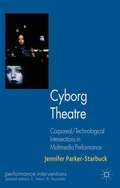- Table View
- List View
Cutting a Figure: Fashioning Black Portraiture
by Richard J. PowellExamining portraits of black people over the past two centuries, Cutting a Figure argues that these images should be viewed as a distinct category of portraiture that differs significantly from depictions of people with other racial and ethnic backgrounds. The difference, Richard Powell contends, lies in the social capital that stems directly from the black subject's power to subvert dominant racist representations by evincing such traits as self-composure, self-adornment, and self-imagining. Powell forcefully supports this argument with evidence drawn from a survey of nineteenth-century portraits, in-depth case studies of the postwar fashion model Donyale Luna and the contemporary portraitist Barkley L. Hendricks, and insightful analyses of images created since the late 1970s. Along the way, he discusses major artists-- such as Frédéric Bazille, John Singer Sargent, James Van Der Zee, and David Hammons--alongside such overlooked producers of black visual culture as the Tonka and Nike corporations. Combining previously unpublished images with scrupulous archival research,Cutting a Figure illuminates the ideological nature of the genre and the centrality of race and cultural identity in understanding modern and contemporary portraiture.
Cutting the Wire: Photographs and Poetry from the US-Mexico Border
by Ray Gonzalez Bruce Berman Welsh LawrenceCutting the Wire, a masterful collaboration between photographer Bruce Berman and poets Ray Gonzalez and Lawrence Welsh, offers us a way to look again, to really look, at the border between Mexico and the United States. Berman, who has photographed and lived in El Paso for decades, is a documentarian who uses his camera to record what&’s in front of him rather than for, as he puts it, &“mere self-expression.&” Berman&’s visual investigations of the everyday realities of the border—detention centers, smeltertown cemeteries, kids playing along a river levee, descanso crosses on telephone poles for the disappeared—are exactly the stuff the poetry of Gonzalez and Welsh is made of. The multilayered histories of the border landscape provide an inexhaustible supply of rich and fertile raw material for both Gonzalez and Welsh. But their poetic visions allow them to capture elements of a personal and collective past that historians have often failed to record.
Cutting-Edge Band Saw Tips & Tricks: How To Get The Most Out Of Your Band Saw (Cutting Edge Ser.)
by Kenneth Burton15 Must-Have Jigs and FixturesIt's time to unleash the full power of your band saw. With Cutting-Edge Band Saw Tips & Tricks, you'll learn how to build 15 jigs and fixtures that will turn your band saw into the most useful tool in the shop. These essential accessories are easy to create with the complete step-by-step photos and instructions inside this book.No matter what you want to build, the techniques found here will make the construction process easier and the finished product better. You'll also find full plans for three gorgeous projects - all designed to harness the muscle of your new jigs and fixtures. Don't miss this chance to use your band saw in ways you never thought you could!
Cuttyhunk and the Elizabeth Islands (Images of America)
by Cuttyhunk Historical SocietyFive of the Elizabeth Islands-Naushon, Pasque, Nashawena, Cuttyhunk, and Penikese-date from 1602, when the Englishman Bartholomew Gosnold explored the waters of Vineyard Sound and Buzzards Bay aboard his ship the Concord. Although the small encampment Gosnold built on Cuttyhunk for trading with the Wampanoags was used for only a few weeks, journals kept by two crew members have survived and give vivid accounts of that voyage. Naushon, Pasque, and Nashawena are currently privately owned. Penikese, once a leper colony, is now the site of a school for troubled boys. Cuttyhunk is now the only island with a village center and easy public access. Captivating photographs and postcards in Cuttyhunk and the Elizabeth Islands trace the special experience of island life from the unspoiled habitat of Gosnold's time to the first invasion of summer folk in the 1950s. These vintage images not only show how the islands' rock-strewn landscapes reflect the hard lives of the early islanders but also attest to the pleasures of picnics and boating as tourism and summer residents brought a modest degree of prosperity. Many previously unpublished photographs of large estates on Naushon portray a life of privilege. Views of Penikese depict the barren dormitories of the lepers who lived out their lives there.
Cuyahoga County: The First 200 Years (Images of America)
by Cuyahoga County Archives Judith G. CetinaCuyahoga County, located on the shores of Lake Erie and the banks of the Cuyahoga, has recently marked its bicentennial, celebrating two centuries of history and achievement. From the county's creation in 1808, to the World War II era and beyond, Cuyahoga County was transformed from a frontier community into a vibrant urban center. Today this part of northeastern Ohio is envied for its distinctive neighborhoods, embrace of various religious creeds, resilient entrepreneurship, ethnically and racially diverse population, political leadership, recreational facilities, splendid cultural and educational institutions, storied sports franchises, and distinguished health facilities. Cuyahoga County government and its citizens are also renowned for their philanthropy and concern for those most vulnerable; championing ideals that ensure everyone an equal place at the table and freedom everywhere. This worldview was rooted in the actions of those who, throughout the centuries, risked their lives and fortunes to attain these goals, giving greater meaning to the area's Underground Railroad code name: HOPE.
Cuyahoga Falls (Postcard History Series)
by Jeri HollandWelcome to Cuyahoga Falls, Ohio, a small American town that epitomizes America itself. With a history dating back to the rough decades when the land was a deep wilderness inhabited by natives and adventure-seeking Europeans, the town grew into an industrial juggernaut, weathered disasters, embraced inventiveness, and spearheaded progress. Between these covers readers will find a treasure trove of postcards from a colorful past. From grand old buildings and daily town life to the natural beauty and resources of the Cuyahoga River, the images in Postcard History Series: Cuyahoga Falls reflect memories of Americana and times long since past.
Cuéntele su Historia al Mundo y Véndala por Millones
by Kenneth Atchity Lisa CerasoliCuéntele su Historia al Mundo y Véndala por Millones, es un libro infaltable tanto para escritores como para guionistas. Posee todo aquello que no le dicen a uno mientras cursa una carrera relacionada con la creación literaria. Pero no solamente son los meros datos de usos y costumbres de los mercados editoriales, también de los nuevos mercados y las posibilidades de una edición electrónica sin pasar por las casas editoriales. ¡Ni hablar de hacer que su historia esté "en forma" para la soñada posibilidad de que su libro se convierta en una película! Este libro lo ayudará efictivamente a contar su historia al mundo, y lo ayudará a venderla por millones!!!
Cwl Wines Of Rioja Ebook
by John RadfordOver the last decade, Spain’s most classic and widely recognized wine region,Rioja, has experienced a tumultuous evolution in its wine industry. This bookdocuments the changes in wine law, the heated debates between the networkof estates, bodegas, and growers, and the problems of overproduction. All aspectsof the wines of Rioja are covered in detail – from the traditional estates to the mostinnovative bodegas to the newest styles of red and white wines available. Thereare comprehensive, indepth profiles of producers and their wines, with opinions and observations from the world’s most recognized expert on Spanish wine.
Cyanotype: The Blueprint in Contemporary Practice (Contemporary Practices in Alternative Process Photography)
by Christina Z AndersonCyanotype: The Blueprint in Contemporary Practice is a two part book on the much admired blue print process. Part One is a comprehensive how-to on the cyanotype process for both beginner and advanced practitioners, with lots of photographs and clear, step-by-step directions and formulas. Part Two highlights contemporary artists who are using cyanotype, making work that ranges from the photographic to the abstract, from the traditional to the conceptual, with tips on their personal cyanotype methods alongside their work. These artists illustrate cyanotype’s widespread use in contemporary photography today, probably the most of any alternative process. Book features include: A brief discussion of the practice of the process with some key historical points How to set up the cyanotype ÒdimroomÓ The most extensive discussion of suitable papers to date, with data from 100+ papers Step-by-step digital negative methods for monochrome and duotone negatives Chapters on classic, new, and other cyanotype formulas Toning to create colors from yellow to brown to violet Printing cyanotype over palladium, for those who want to temper cyanotype’s blue nature Printing cyanotype on alternate surfaces such as fabric, glass, and wood More creative practice ideas for cyanotype such as handcoloring and gold leafing Troubleshooting cyanotype, photographically illustrated Finishing, framing, and storing cyanotype Contemporary artists’ advice, techniques, and works Cyanotype is backed with research from 120 books, journals, and magazine articles from 1843 to the present day. It is richly illustrated with 400 photographs from close to 80 artists from 14 countries. It is a guide for the practitioner, from novice to expert, providing inspiration and proof of cyanotype’s original and increasing place in historical and contemporary photography.
Cyber Risk Management in Practice: A Guide to Real-World Solutions (Security, Audit and Leadership Series)
by Carlos MoralesCyber Risk Management in Practice: A Guide to Real-World Solutions is your companion in the ever-changing landscape of cybersecurity. Whether you're expanding your knowledge or looking to sharpen your existing skills, this book demystifies the complexities of cyber risk management, offering clear, actionable strategies to enhance your organization's security posture. With a focus on real-world solutions, this guide balances practical application with foundational knowledge.Key Features: Foundational Insights: Explore fundamental concepts, frameworks, and required skills that form the backbone of a strong and pragmatic cyber risk management program tailored to your organization’s unique needs. It covers everything from basic principles and threat modeling to developing a security-first culture that drives change within your organization. You’ll also learn how to align cybersecurity practices with business objectives to ensure a solid approach to risk management. Practical Application: Follow a hands-on step-by-step implementation guide through the complete cyber risk management cycle, from business context analysis to developing and implementing effective treatment strategies. This book includes templates, checklists, and practical advice to execute your cyber risk management implementation, making complex processes manageable and straightforward. Real-world scenarios illustrate common pitfalls and effective solutions. Advanced Strategies: Go beyond the basics to achieve cyber resilience. Explore topics like third-party risk management, integrating cybersecurity with business continuity, and managing the risks of emerging technologies like AI and quantum computing. Learn how to build a proactive defense strategy that evolves with emerging threats and keeps your organization secure. “Cyber Risk Management in Practice: A Guide to Real-World Solutions by Carlos Morales serves as a beacon for professionals involved not only in IT or cybersecurity but across executive and operational roles within organizations. This book is an invaluable resource that I highly recommend for its practical insights and clear guidance” – José Antonio Fernández Carbajal. Executive Chairman and CEO of FEMSA
Cyber Security, Forensics and National Security (Advances in Digital Technologies for Smart Applications)
by Adarsh Kumar Vinay Aseri Sumit Kumar ChoudharyThe book serves two very important purposes. One the concept and vulnerabilities due to cyber attacks in all walks of lives are explained along with how to detect and reduce the risk through digital forensics. Secondly, how such threats at a larger proportion puts entire national security on stake. Thus, there are lot of take-aways as the book discusses for the first-time various dimensions of national security, the risks involved due to cyber threats and ultimately the prevention & detection through cyber forensics and cyber security architectures. This book empowers readers with a deep comprehension of the various cyber threats targeting nations, businesses, and individuals, allowing them to recognize and respond to these threats effectively. It provides a comprehensive guide to digital investigation techniques, including evidence collection, analysis, and presentation in a legal context, addressing a vital need for cybersecurity professionals and law enforcement. The book navigates the complex legal and policy considerations surrounding cybercrime and national security, ensuring readers are well-versed in compliance and ethical aspects. The primary purpose of "Cyber Forensics and National Security" is to fill a critical gap in the realm of literature on cybersecurity, digital forensics, and their nexus with national security. The need for this resource arises from the escalating threats posed by cyberattacks, espionage, and digital crimes, which demand a comprehensive understanding of how to investigate, respond to, and prevent such incidents.1) The book consists of content dedicated to national security to maintain law enforcement and investigation agencies. 2) The book will act as a compendium for undertaking the initiatives for research in securing digital data with national security with the involvement of intelligence agencies.3) The book focuses on real-world cases and national security from government agencies, law enforcement, and digital security firms, offering readers valuable insights into practical applications and lessons learned in digital forensics. and innovative methodologies aimed at enhancing the availability of digital forensics and national security tools and techniques.4) The book explores cutting-edge technologies in the field of digital forensics and national security, leveraging computational intelligence for enhanced reliability engineering, sustainable practices, and more.Readers gain insights into the critical role of cyber forensics in national security, helping them appreciate the strategic importance of safeguarding digital assets and infrastructure. For academicians and professional, this book serves as a valuable educational resource, offering instructors a comprehensive text for courses in cybersecurity, digital forensics, and national security studies. "Cyber Forensics and National Security" is a timely and essential resource that equips readers with the knowledge and tools required to confront the evolving challenges of our interconnected, digital world, ultimately contributing to the defence of national interests in cyberspace. This book will also be useful for postgraduate and researchers in identifying recent issues and challenges with cybersecurity and forensics. The academic disciplines where this book will be useful include: computer science and engineering, information technology, electronics and communication, and physics. The titles of courses where this book will be useful (but not limited to) include: Cybersecurity, Forensics, Digital Forensics, Cryptography, Network Security, Secure Computing Technologies , Transferable Machine and Deep learning and many more.
Cyber Warfare, Security and Space Research: First International Conference, SpacSec 2021, Jaipur, India, December 9–10, 2021, Revised Selected Papers (Communications in Computer and Information Science #1599)
by Sandeep Joshi Amit Kumar Bairwa Amita Nandal Milena Radenkovic Cem AvsarThis book sonstitutes selected papers from the first International Conference on Cyber Warfare, Security and Space Research, SpacSec 2021, held in Jaipur, India, in December 2021.The 19 full and 6 short papers were thoroughly reviewed and selected from the 98 submissions. The papers present research on cyber warfare, cyber security, and space research area, including the understanding of threats and risks to systems, the development of a strong innovative culture, and incident detection and post-incident investigation.
Cyber-Physical Systems in the Built Environment
by Chimay J. Anumba Nazila Roofigari-EsfahanThis book introduces researchers and practitioners to Cyber-Physical Systems (CPS) and its applications in the built environment. It begins with a fundamental introduction to CPS technology and associated concepts.It then presents numerous examples of applications from managing construction projects to smart transportation systems and smart cities. It concludes with a discussion of future directions for CPS deployment in the construction, operation and maintenance of constructed facilities. Featuring internationally recognized experts as contributors, Cyber-Physical Systems in the Built Environment, is an ideal resource for engineers, construction managers, architects, facilities managers, and planners working on a range of building and civil infrastructure projects.
CyberMedics: Navigating AI and Security in the Medical Field
by Rohit Tanwar Varun Sapra Luxmi SapraCyberMedics: Navigating AI and Security in the Medical Field is a comprehensive exploration of the transformative role of artificial intelligence (AI) in healthcare and the critical importance of securing medical data in an increasingly digital world. As AI technologies revolutionize diagnostics, treatment planning, and patient care, they also introduce new challenges related to data privacy, ethical considerations, and cybersecurity. This book offers a balanced perspective, providing healthcare professionals, technologists, and policymakers with the tools they need to understand and navigate the intersection of AI and security. Through detailed case studies, expert insights, and practical guidance, readers will discover how AI can be leveraged to improve patient outcomes while maintaining the highest standards of data protection.Key topics include: AI in healthcare, exploring how emerging technologies like machine learning, natural language processing, and predictive analytics are poised to reshape the industry the ethical implications of AI in healthcare strategies for safeguarding sensitive information against cyber threats future frameworks governing the use of AI in medical settings Whether you’re on the front lines of patient care, involved in healthcare IT, or shaping policy, CyberMedics: Navigating AI and Security in the Medical Field equips you with the knowledge to make informed decisions in a rapidly evolving landscape, ensuring that innovation and security go hand in hand to enhance the quality of care.
Cybernetic Architectures: Informational Thinking and Digital Design (Routledge Research in Architecture)
by Camilo Andrés Cifuentes QuinFor the past 50 years, the advancements of technology have equipped architects with unique tools that have enabled the development of new computer-mediated design methods, fabrication techniques, and architectural expressions. Simultaneously, in contemporary architecture new frameworks emerged that have radically redefined the traditional conceptions of design, of the built environment, and of the role of architects. Cybernetic Architectures argues that such frameworks have been constructed in direct reference to cybernetic thinking, a thought model that emerged concurrently with the origins of informatics and that embodies the main assumptions, values, and ideals underlying the development of computer science. The book explains how the evolution of the computational perspective in architecture has been parallel to the construction of design issues in reference to the central ideas fostered by the cybernetic model. It unpacks and explains this crucial relationship, in the work of digital architects, between the use of information technology in design and the conception of architectural problems around an informational ontology. This book will appeal to architecture students and scholars interested in understanding the recent transformations in the architectural landscape related to the advent of computer-based design paradigms.
Cybernetic-Existentialism: Freedom, Systems, and Being-for-Others in Contemporary Arts and Performance
by Steve DixonCybernetic-Existentialism: Freedom, Systems, and Being-for-Others in Contemporary Arts and Performance offers a unique discourse and an original aesthetic theory. It argues that fusing perspectives from the philosophy of Existentialism with insights from the ‘universal science’ of cybernetics provides a new analytical lens and deconstructive methodology to critique art. In this study, Steve Dixon examines how a range of artists’ works reveal the ideas of Existentialist philosophers including Kierkegaard, Camus, de Beauvoir, and Sartre on freedom, being and nothingness, eternal recurrence, the absurd, and being-for-others. Simultaneously, these artworks are shown to engage in complex explorations of concepts proposed by cyberneticians including Wiener, Shannon, and Bateson on information theory and ‘noise’, feedback loops, circularity, adaptive ecosystems, autopoiesis, and emergence. Dixon’s groundbreaking book demonstrates how fusing insights and knowledge from these two fields can throw new light on pressing issues within contemporary arts and culture, including authenticity, angst and alienation, homeostasis, radical politics, and the human as system.
Cybernetics and the Constructed Environment: Design Between Nature and Technology
by Zihao ZhangGrounded in contemporary landscape architecture theory and practice, Cybernetics and the Constructed Environment blends examples from art, design, and engineering with concepts from cybernetics and posthumanism, offering a transdisciplinary examination of the ramifications of cybernetics on the constructed environment. Cybernetics, or the study of communication and control in animals and machines, has grown increasingly relevant nearly 80 years after its inception. Cyber-physical systems, sensing networks, and spatial computing—algorithms and intelligent machines—create endless feedback loops with human and non-human actors, co-producing a cybernetic environment. Yet, when an ecosystem is meticulously managed by intelligent machines, can we still call it wild nature? Posthumanism ideas, such as new materialism, actor-network theory, and object-oriented ontology, have become increasingly popular among design disciplines, including landscape architecture, and may have provided transformative frameworks to understand this entangled reality. However, design still entails a sense of intentionality and an urge to control. How do we, then, address the tension between the designer’s intentionality and the co-produced reality of more-than-human agents in the cybernetic environment? Is posthumanism enough to develop a framework to think beyond our all-too-human ways of thinking? For researchers, scholars, practitioners, and students in environmental design and engineering disciplines, this book maps out a paradigm of environmentalism and ecological design rooted in non-communication and uncontrollability, and puts a speculative turn on cybernetics.Chapters 8 and 9 of this book are freely available as a downloadable Open Access PDF at http://www.taylorfrancis.com under a Creative Commons Attribution-Non Commercial-No Derivatives (CC-BY-NC-ND) 4.0 license.
Cybernetics of Art: Reason and the Rainbow (Routledge Revivals)
by M. J. RosenbergFirst published in 1983, Cybernetics of Art uses the methodology and concepts of cybernetics to explore art and the creative process. Part I surveys the domain that includes both science and the arts, attempting to understand their differing viewpoints- and the basis of conflicts between them. Art is approached as a method of knowledge aimed at knowledge of experience per se (as distinct from knowledge derived through experience).Part II poses the problem of notionally constructing an authorship machine and develops the technical argument by exploring the question of the kind of machine it would need to be. Part III examines the products of such a machine with a view to finding criteria for distinguishing those that might be called art. An extended, non-technical commentary accompanies the text throughout, with the dual aim of comparing the book’s technical conclusions with ideas expressed by critiques and practicing artists and assisting readers unfamiliar with the information sciences in following the argument. In a world dominated by artificial intelligence, this interdisciplinary book will be useful for scholars and researchers of cybernetics, art, and humanities and social sciences in general.
Cyberpop: Digital Lifestyles and Commodity Culture (Routledge Studies in New Media and Cyberculture #Vol. 3)
by Sidney Eve MatrixCyberpop is an analysis of cyberculture and its popular cultural productions. The study begins with a Foucaultian model of cyberculture as a discursive formation, and explains how some key concepts (such as 'virtuality,' 'speed,' and 'Connectivity') operate as a conceptual architecture network linking technologies to information and individual subjects. The chapters then each focus on a particular cyberfiguration, including Hollywood films (GATTACA, The Matrix), popular literature (William Gibson's Neuromancer, Scott Westerfeld's Polymorph), advertising for digital products and services (Apple Computer's '1984/McIntosh' campaign, AT&T's 'mLife' campaign), digital artworks (including virtual females such as Motorola's 'Mya' and Elite Modeling Agency's 'Webbie Tookay,' and work by visual artist Daniel Lee for Microsoft's 'Evolution' campaign), and video games (Tomb Raider). Each close reading illustrates the ways in which representations of digital lifestyles and identities - which typically fetishize computers and celebrate a 'high tech' aesthetic encourage participation in digital capitalism and commodity cyberculture. Matrix argues that popular representations of cyberculture often function as forms of social criticism that creatively inspire audiences to 'think different' (in the words of Mac advertising) about the consequences of the digitalization of everyday life.
Cybersecurity in Knowledge Management: Cyberthreats and Solutions
by Narasimha Rao Vajjhala Kenneth David StrangIn an era where digital transformation is vital across industries, protecting knowledge and information assets has become critical. Cybersecurity in Knowledge Management: Cyberthreats and Solutions explores the intersection of knowledge management and cybersecurity, offering an in-depth examination of the strategies, technologies, and frameworks necessary to safeguard organizational knowledge systems. As cyber threats grow more sophisticated, particularly within sectors such as digital marketing, supply chains, and higher education, this book examines methods for enhancing cybersecurity while maintaining the agility needed to foster innovation. By incorporating perspectives from artificial intelligence, machine learning, and human factors, this work provides a holistic approach to securing knowledge in today’s interconnected landscape.This book includes an analysis of AI and machine learning applications for cybersecurity, a comparative review of malware classification techniques, and real-world case studies illustrating cybersecurity breaches and insider threats affecting knowledge ecosystems. This book addresses unique challenges within the African digital space, explores social engineering tactics, and emphasizes the role of organizational culture in maintaining knowledge security. Key topics include cybersecurity requirements in digital marketing, the post-COVID impact on knowledge transfer in higher education, and the importance of regulatory compliance and cross-industry collaboration.With its multidisciplinary perspective, Cybersecurity in Knowledge Management: Cyberthreats and Solutions is ideal for professionals, researchers, and policymakers. This comprehensive guide equips readers with the insights needed to build resilient cybersecurity programs that protect essential knowledge assets, enabling organizations to meet today’s cybersecurity demands while maintaining a sustainable competitive advantage in an evolving digital environment.
Cyberspace Data and Intelligence, and Cyber-Living, Syndrome, and Health: International 2019 Cyberspace Congress, CyberDI and CyberLife, Beijing, China, December 16–18, 2019, Proceedings, Part I (Communications in Computer and Information Science #1137)
by Huansheng NingThis two-volume set (CCIS 1137 and CCIS 1138) constitutes the proceedings of the Third International Conference on Cyberspace Data and Intelligence, Cyber DI 2019, and the International Conference on Cyber-Living, Cyber-Syndrome, and Cyber-Health, CyberLife 2019, held under the umbrella of the 2019 Cyberspace Congress, held in Beijing, China, in December 2019. The 64 full papers presented together with 18 short papers were carefully reviewed and selected from 160 submissions. The papers are grouped in the following topics: Cyber Data, Information and Knowledge; Cyber and Cyber-enabled Intelligence; Communication and Computing; Cyber Philosophy, Cyberlogic and Cyber Science; and Cyber Health and Smart Healthcare.
Cyberspace Data and Intelligence, and Cyber-Living, Syndrome, and Health: International 2019 Cyberspace Congress, CyberDI and CyberLife, Beijing, China, December 16–18, 2019, Proceedings, Part II (Communications in Computer and Information Science #1138)
by Huansheng NingThis two-volume set (CCIS 1137 and CCIS 1138) constitutes the proceedings of the Third International Conference on Cyberspace Data and Intelligence, Cyber DI 2019, and the International Conference on Cyber-Living, Cyber-Syndrome, and Cyber-Health, CyberLife 2019, held under the umbrella of the 2019 Cyberspace Congress, held in Beijing, China, in December 2019. The 64 full papers presented together with 18 short papers were carefully reviewed and selected from 160 submissions. The papers are grouped in the following topics: cyber data, information and knowledge; cyber and cyber-enabled intelligence; communication and computing; cyber philosophy, cyberlogic and cyber science; and cyber health and smart healthcare.
Cyberspace Data and Intelligence, and Cyber-Living, Syndrome, and Health: International 2020 Cyberspace Congress, CyberDI/CyberLife 2020, Beijing, China, December 10–12, 2020, Proceedings (Communications in Computer and Information Science #1329)
by Huansheng Ning Feifei ShiThis volume constitutes the proceedings of the Forth International Conference on Cyberspace Data and Intelligence, Cyber DI 2020, and the International Conference on Cyber-Living, Cyber-Syndrome, and Cyber-Health, CyberLife 2020, held under the umbrella of the 2020 Cyberspace Congress, held in Beijing, China, in December 2020.*The 13 full papers presented were carefully reviewed and selected from 36 submissions. The papers are grouped in the following topics: machine learning and ubiquitous and intelligent computing. * The conference was held virtually due to the COVID-19 pandemic.
Cyborg Babies: From Techno-Sex to Techno-Tots
by Joseph Dumit Robbie Davis-FloydFrom fetuses scanned ultrasonically to computer hackers in daycare, contemporary children are increasingly rendered cyborg by their immersion in technoculture. As we are faced with reproductive choices connected directly with technologies, we often have trouble gaining perspective on our own cultural co-dependency with these very same technologies. Our notions of fetal health, maternal risk and child IQ are inseparable from them. Cyborg Babies tracks the process of reproducing children in symbiosis with pervasive technology and offers a range of perspectives, from resistance to ethnographic analysis to science fiction. Cultural anthropologists and social critics offer cutting-edge ethnographies, critiques, and personal narratives of cyborg conceptions (sperm banks, IVF, surrogacy) and prenatal (mis)diagnosis (DES, ultrasound, amniocentesis); the technological de- and reconstruction of birth in the hospital (electronic fetal monitors, epidurals); and the effects of computer simulation games and cyborg toys and stories on children's emergent consciousness. Contributors include Janet Isaacs Ashford, Elizabeth Cartwright, David Chamberlain, Jennifer Croissant, Charis M. Cussins, Robbie Davis-Floyd, Joseph Dumit, Eugenia Georges, Anne Hill, Mizuko Ito, Emily Martin, Steven Daniel Mentor, Janneli F. Miller, Lisa Mitchell, Lisa Jean Moore, Rayna Rapp, Matthew A. Schmidt, Syvia Sensiper, Elizabeth Roberts and Sherry Turkle. Examining the increasing cyborgification of the American child, from conception through birth and beyond, Cyborg Babies considers its implications for human cultural and psychological evolution.
Cyborg Theatre
by Jennifer Parker-StarbuckThis book articulates the first theoretical context for a 'cyborg theatre,' metaphorically integrating on-stage bodies with the technologized, digitized, or mediatized, to re-imagine subjectivity for a post-human age. It covers a variety of examples, to propose new theoretical tools for understanding performance in our changing world.

